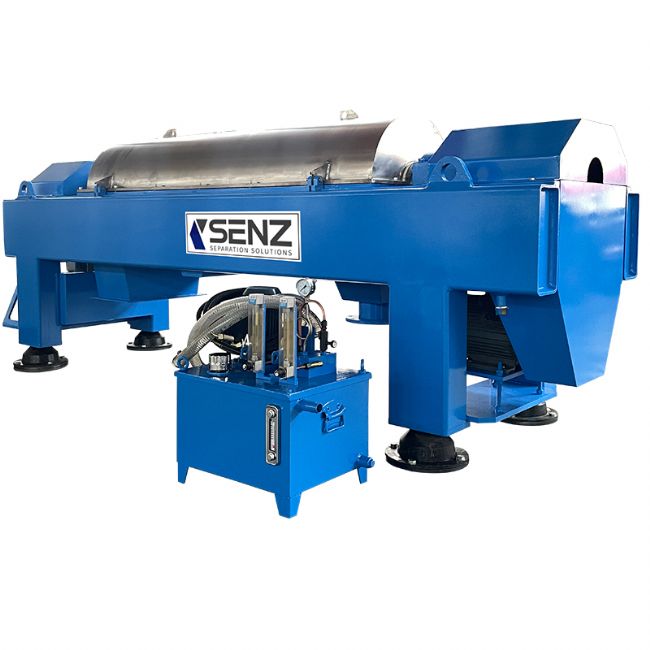Types of Wastewater
Wastewater is a generic term for water with solid or liquid contaminants. For example, municipal wastewater has organic sludge, and industrial wastewater carries industrial or inorganic sludge, etc.
Generation in large volumes is the other aspect of wastewater; therefore, the separation equipment must process large amounts of contaminated fluid.
Wastewater from the sources, as mentioned earlier, contains bulk sludge, which is easier to separate. On the other hand, wastewater from mines and oilfield drilling operations contains fine, suspended solids requiring smaller mesh filtration or higher g-force centrifuges.
We also have industrial effluent water, which contains oil in addition to the solids or sludge. This application may need two different centrifuges to separate the sludge and the oil from the de-sludged water.
Wastewater Centrifuges - Types and Capacities
Separation Technologies
Filtration is not an option for this application, given the type and volume of wastewater that needs to be purified. Other separation technologies, such as belts and filter presses, have limited uses in wastewater separation duties. Again, these technologies have drawbacks, including labor and equipment reliability issues that limit their widespread use in wastewater treatment plants.
Mechanical separation using a wastewater centrifuge has many advantages for continuously processing large quantities of wastewater. As with all technologies, centrifuges also have some drawbacks highlighted below.
 Operation
Operation
A wastewater centrifuge is a separation machine that utilizes a centrifugal force of 3,100 Gs to separate the wastewater from sludge. The sludge accumulates on the bowl periphery, and the internal auger scrapes towards the sludge discharge ports. The water flows out through the bowl's liquid outlet at the opposite end.
Sludge Thickening or Dewatering Type
A sludge dewatering or sludge thickening centrifuge is a decanter-type horizontal de-sludger that can remove water from slurries to thicken the sludge. In other words, a heavy-duty industrial centrifuge dewaters and concentrates (thickens) the sludge, also known as a sludge thickening machine. These machines are available in different sizes to continuously process large quantities of sludge-laden water.
Livestock farm manure, municipal sewage, car washes, and oilfield drilling mud produce wastewater with high sludge content of up to 50%. The primary objective of such applications is to reduce the sludge volume to minimize handling and disposal costs. The recovered water is often clean enough to be reused or discharged with minimal environmental impact.
Technical Parameter
|
Models
|
Drum diameter
(mm)
|
Rotation rate of Drum
(r/min)
|
Relative centrifugal force
|
Motor power(kw)
|
Productively
M3/h
|
Weight(kg)
|
Dimension (L*W*H)mm
|
|
LW250x900
|
250
|
5400
|
4000
|
11
|
1-5
|
1050
|
1800*1200*600
|
|
LW360x1200
|
360
|
1200
|
4200
|
15
|
3-12
|
2100
|
2600*1580*1040
|
|
LW360x1500
|
360
|
4200
|
3550
|
22
|
3-14
|
2600
|
2900*1600*1040
|
|
LW420x1750
|
420
|
4000
|
3750
|
37/45
|
6-30
|
3500
|
3120*1580*1070
|
|
LW420x2100
|
420
|
4000
|
3750
|
45
|
6-35
|
4100
|
3450*1580*1070
|
|
LW500x2000
|
500
|
3800
|
4000
|
45/55
|
10-40
|
6500
|
3600*2300*1400
|
|
LW500x2500
|
500
|
3800
|
4000
|
55/75
|
12-45
|
7200
|
4100*2300*1400
|
|
LW550x1900
|
550
|
3200
|
3154
|
45/55
|
13-50
|
4600
|
3400*1810*1110
|
|
LW550x2400
|
550
|
3200
|
3154
|
55/75
|
13-55
|
5600
|
3900*1810*1110
|
|
LW650x2000
|
650
|
2650
|
2500
|
55/75
|
15-65
|
7100
|
4000*2300*1400
|
bio-equip.cn





 Operation
Operation